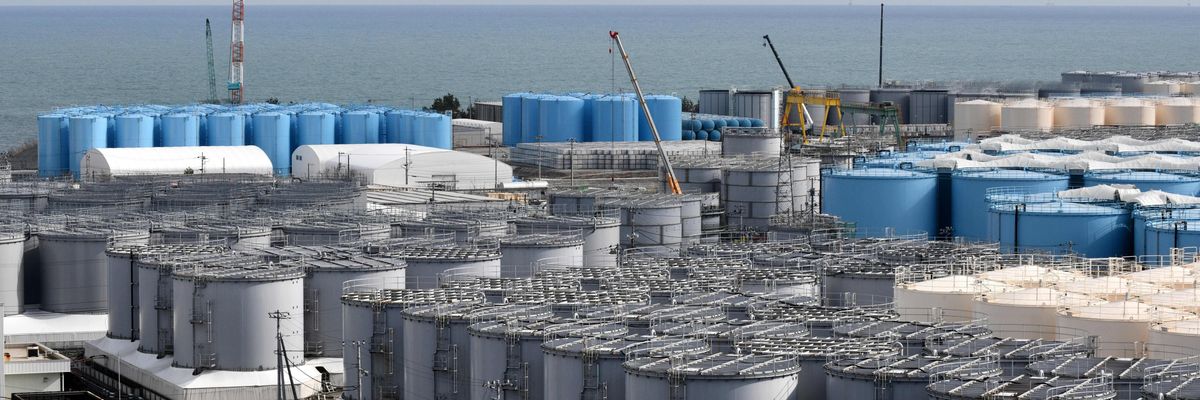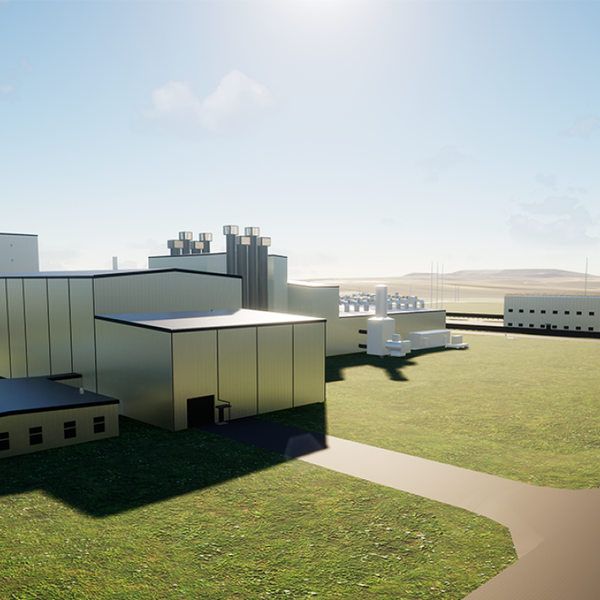
This picture taken on February 3, 2020 shows storage tanks for contaminated water at the Tokyo Electric Power Company's (TEPCO) Fukushima Daiichi nuclear power plant in Okuma, Fukushima prefecture in Japan. (Photo: Kazuhiro Nogi/AFP via Getty Images)
Plan to Discharge Fukushima Water Into Pacific Gets OK From Regulators
The discharge could release a number of radioactive isotopes into the Pacific Ocean, critics say.
Despite outcry from local leaders and the Japanese public and warnings from environmental campaigners, Japan's Nuclear Regulation Authority on Wednesday gave its approval for a plan to discharge contaminated water from Fukushima Daiichi nuclear power plant into the Pacific Ocean, a move critics say will pose a major threat to marine life.
After spending several months reviewing the plan announced by then-Prime Minister Yoshihide Suga's administration last spring, the NRA said discharging more than 1.2 million tons of treated wastewater will help the Tokyo Electric Power Company (TEPCO) secure space needed to decommission the plant, where three reactors melted down in March 2011 after a tsunami.
Assuming the plan goes forward, the discharge is expected to begin in 2023, but critics including the governor of a neighboring prefecture are calling on TEPCO and the Japanese government to consider other options.
"We just hope people in the fisheries industry will be able to continue fishing with peace of mind."
The plan "will extensively affect many industries in the prefecture, including fisheries, that are only now recovering from the earthquake damage," said Gov. Yoshihiro Murai of Miyagi Prefecture last year after the central government proposed the discharge.
TEPCO will use an Advanced Liquid Processing System (ALPS) to treat wastewater that has been pumped in to Fukushima to cool fuel from the melted reactors and has mixed with rainwater and groundwater since the tsunami.
According to TEPCO, the water will be diluted to one-40th of the concentration permitted in Japan.
The system, however, is not able to remove tritium, a radioactive isotope of hydrogen, from the water. South Korean officials and fishing communities in the area have expressed concern that tritium will harm marine life in the Pacific.
TEPCO also acknowledged in 2018 that other isotopes including ruthenium, cobalt, strontium, and plutonium, "sometimes slip through the ALPS process," according to Science.
"These radioactive isotopes behave differently than tritium in the ocean and are more readily incorporated into marine biota or seafloor sediments," Ken Buesseler, a marine chemist at the Woods Hole Oceanographic Institution, told the magazine last year.
The Japan Fisheries Cooperatives told Prime Minister Fumio Kishida last month that its opposition to the water discharge plan, which it previously stated last year, "remains exactly the same."
"We just hope people in the fisheries industry will be able to continue fishing with peace of mind," Hiroshi Kishi, head of the cooperative, told Kyodo News.
Following the NRA's endorsement, the discharge plan could be officially approved as early as July. The International Atomic Energy Agency will begin an inspection of the Fukushima plant Thursday, with South Korean officials participating in monitoring the plan.
An Urgent Message From Our Co-Founder
Dear Common Dreams reader, The U.S. is on a fast track to authoritarianism like nothing I've ever seen. Meanwhile, corporate news outlets are utterly capitulating to Trump, twisting their coverage to avoid drawing his ire while lining up to stuff cash in his pockets. That's why I believe that Common Dreams is doing the best and most consequential reporting that we've ever done. Our small but mighty team is a progressive reporting powerhouse, covering the news every day that the corporate media never will. Our mission has always been simple: To inform. To inspire. And to ignite change for the common good. Now here's the key piece that I want all our readers to understand: None of this would be possible without your financial support. That's not just some fundraising cliche. It's the absolute and literal truth. We don't accept corporate advertising and never will. We don't have a paywall because we don't think people should be blocked from critical news based on their ability to pay. Everything we do is funded by the donations of readers like you. Will you donate now to help power the nonprofit, independent reporting of Common Dreams? Thank you for being a vital member of our community. Together, we can keep independent journalism alive when it’s needed most. - Craig Brown, Co-founder |
Despite outcry from local leaders and the Japanese public and warnings from environmental campaigners, Japan's Nuclear Regulation Authority on Wednesday gave its approval for a plan to discharge contaminated water from Fukushima Daiichi nuclear power plant into the Pacific Ocean, a move critics say will pose a major threat to marine life.
After spending several months reviewing the plan announced by then-Prime Minister Yoshihide Suga's administration last spring, the NRA said discharging more than 1.2 million tons of treated wastewater will help the Tokyo Electric Power Company (TEPCO) secure space needed to decommission the plant, where three reactors melted down in March 2011 after a tsunami.
Assuming the plan goes forward, the discharge is expected to begin in 2023, but critics including the governor of a neighboring prefecture are calling on TEPCO and the Japanese government to consider other options.
"We just hope people in the fisheries industry will be able to continue fishing with peace of mind."
The plan "will extensively affect many industries in the prefecture, including fisheries, that are only now recovering from the earthquake damage," said Gov. Yoshihiro Murai of Miyagi Prefecture last year after the central government proposed the discharge.
TEPCO will use an Advanced Liquid Processing System (ALPS) to treat wastewater that has been pumped in to Fukushima to cool fuel from the melted reactors and has mixed with rainwater and groundwater since the tsunami.
According to TEPCO, the water will be diluted to one-40th of the concentration permitted in Japan.
The system, however, is not able to remove tritium, a radioactive isotope of hydrogen, from the water. South Korean officials and fishing communities in the area have expressed concern that tritium will harm marine life in the Pacific.
TEPCO also acknowledged in 2018 that other isotopes including ruthenium, cobalt, strontium, and plutonium, "sometimes slip through the ALPS process," according to Science.
"These radioactive isotopes behave differently than tritium in the ocean and are more readily incorporated into marine biota or seafloor sediments," Ken Buesseler, a marine chemist at the Woods Hole Oceanographic Institution, told the magazine last year.
The Japan Fisheries Cooperatives told Prime Minister Fumio Kishida last month that its opposition to the water discharge plan, which it previously stated last year, "remains exactly the same."
"We just hope people in the fisheries industry will be able to continue fishing with peace of mind," Hiroshi Kishi, head of the cooperative, told Kyodo News.
Following the NRA's endorsement, the discharge plan could be officially approved as early as July. The International Atomic Energy Agency will begin an inspection of the Fukushima plant Thursday, with South Korean officials participating in monitoring the plan.
Despite outcry from local leaders and the Japanese public and warnings from environmental campaigners, Japan's Nuclear Regulation Authority on Wednesday gave its approval for a plan to discharge contaminated water from Fukushima Daiichi nuclear power plant into the Pacific Ocean, a move critics say will pose a major threat to marine life.
After spending several months reviewing the plan announced by then-Prime Minister Yoshihide Suga's administration last spring, the NRA said discharging more than 1.2 million tons of treated wastewater will help the Tokyo Electric Power Company (TEPCO) secure space needed to decommission the plant, where three reactors melted down in March 2011 after a tsunami.
Assuming the plan goes forward, the discharge is expected to begin in 2023, but critics including the governor of a neighboring prefecture are calling on TEPCO and the Japanese government to consider other options.
"We just hope people in the fisheries industry will be able to continue fishing with peace of mind."
The plan "will extensively affect many industries in the prefecture, including fisheries, that are only now recovering from the earthquake damage," said Gov. Yoshihiro Murai of Miyagi Prefecture last year after the central government proposed the discharge.
TEPCO will use an Advanced Liquid Processing System (ALPS) to treat wastewater that has been pumped in to Fukushima to cool fuel from the melted reactors and has mixed with rainwater and groundwater since the tsunami.
According to TEPCO, the water will be diluted to one-40th of the concentration permitted in Japan.
The system, however, is not able to remove tritium, a radioactive isotope of hydrogen, from the water. South Korean officials and fishing communities in the area have expressed concern that tritium will harm marine life in the Pacific.
TEPCO also acknowledged in 2018 that other isotopes including ruthenium, cobalt, strontium, and plutonium, "sometimes slip through the ALPS process," according to Science.
"These radioactive isotopes behave differently than tritium in the ocean and are more readily incorporated into marine biota or seafloor sediments," Ken Buesseler, a marine chemist at the Woods Hole Oceanographic Institution, told the magazine last year.
The Japan Fisheries Cooperatives told Prime Minister Fumio Kishida last month that its opposition to the water discharge plan, which it previously stated last year, "remains exactly the same."
"We just hope people in the fisheries industry will be able to continue fishing with peace of mind," Hiroshi Kishi, head of the cooperative, told Kyodo News.
Following the NRA's endorsement, the discharge plan could be officially approved as early as July. The International Atomic Energy Agency will begin an inspection of the Fukushima plant Thursday, with South Korean officials participating in monitoring the plan.

